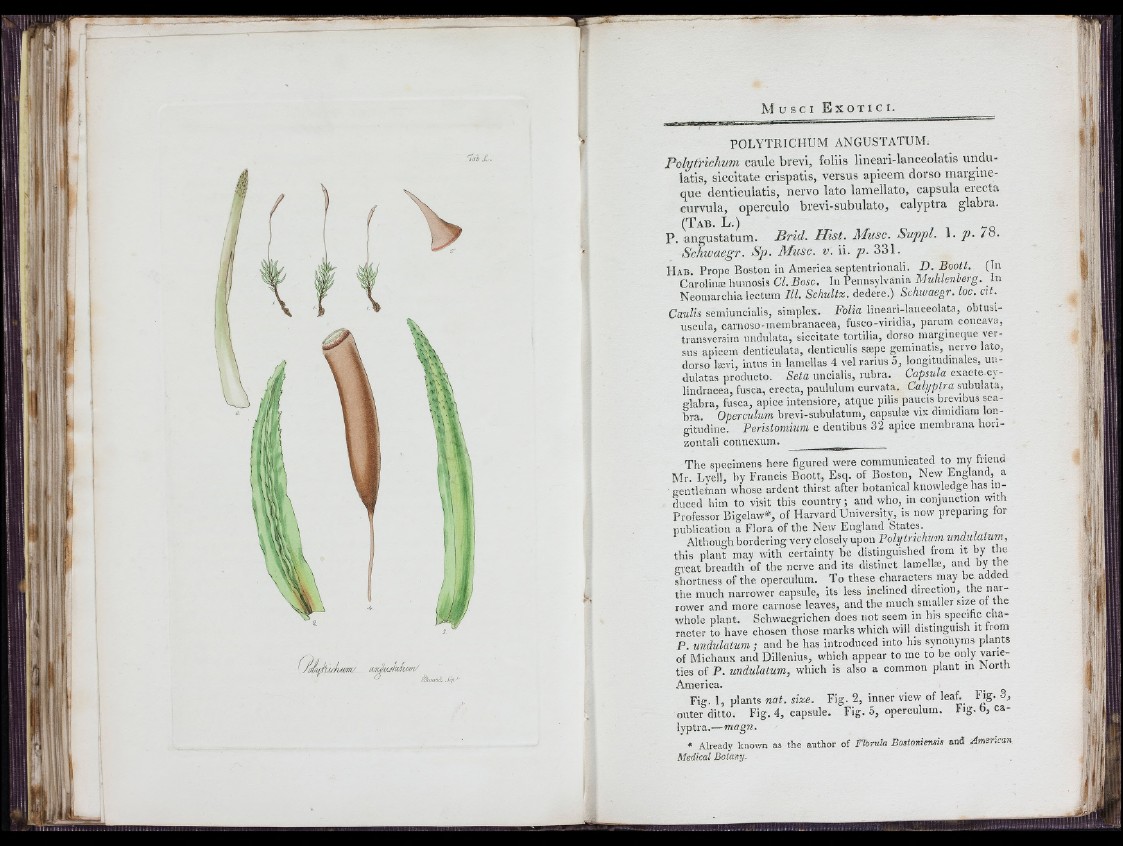
'jaà Xjl
'’M/ocm/ dmuMu/m/
ò„ J(p ‘
POLYTRICHUM ANGUSTATUM.
P o ly tr id iu m caule brevi, foliis lineari-lanceolatis undulatis,
siccitate crispatis, versus apicem dorso margine-
que denticulatis, nervo iato lamellato, capsula erecta
curvula, operculo brevi-subulato, calyptra glabra.
P. angustatum. Brid. Hist. Musc. Suppl. 1. p . 78.
Schwaegr. Sp. Muse. v. ii. p . 331.
H a b . P r o p e Boston in America septentvionali. D . Booti. (In
Caroliuæ humosis Cl. Bose. In Pennsylvania Muhlenherg. In
Neoniarchialectum III. Schultz, dedere.) Schwaegr. h e. a t.
Caulis semiuncialis, simplex. Folia lin e a n /u c e o la ta , obtusiuscula,
carnoso-membranacea, fusco-viridia, parum concava,
transversim undulata, siccitate tortilla, dorso margineque versus
apicem denticulata, denticulis sæpe gemmatis, nervo lato,
dorso lævi, intus in lamcllas 4 vel rarius 3, longitudinales, uu-
dulatas producto. Seta uncialis, rubra. Capsula exacte cylindracea,
fusca, erecta, paululum curvata. Calyptra subulata,
glabra, fusca, apice intensiore, atque pilis paucis brevibus scabra.
Operculum brevi-subulatmn, capsulæ vix dimidiam longitudine.
Peristomium e dentibus 32 apice membrana horizontali
connexum. ______
The specimens here figured were communicated to my friend
Mr. Lvell, by Francis Boott, Esq. of Boston, New England, a
gentletnan whose ardent thirst after botanical knowledge has induced
him to visit this country ; and who, in conjunction with
Professor Bigelaw*, of Harvard University, is now preparing tor
iiubiication a Flora of the New England States
Although bordering very closely upon Polytrichum undulaturn,
this plant may with certainty be distinguished from it by the
great breadth of the nerve and its distinct lamellæ, and by the
shortness of the operculum. To these characters may be added
the much narrower capsule, its less inclined direction, the narrower
and more carnose leaves, and the much smaller .size of the
whole plant. Schwaegrichen does not seem in his specific clia-
racter to have chosen those marks which will distinguish it rrora
P . undidahcm ; and he has introduced into his synonyms plants
of Michaux and Dillenius, which appear to me to be only varieties
of P. undulaturn, which is also a common plant in North
America.
Fig. 1, plants nat. size. Fig. 2, inner view of leaf Fig. 3,
outer ditto. Fig. 4, capsule. Fig. 5, operculum, big. bj calyptra.—
magn.
» A l r e a d y k n o w n a s t h e a u t h o r o f F l ù r u l a B o s t o n i e r T t s a n d A m s r . c a n
M e d i c a l B o t a n y .
ii
Mi
iq-il